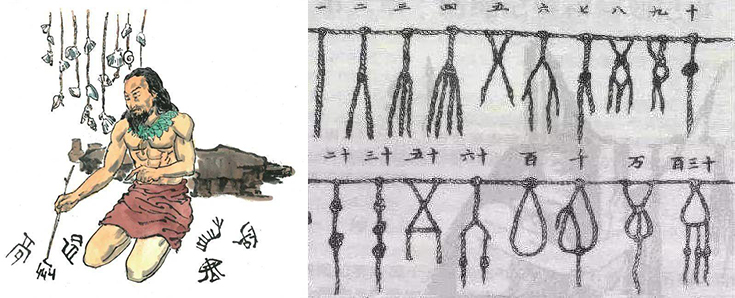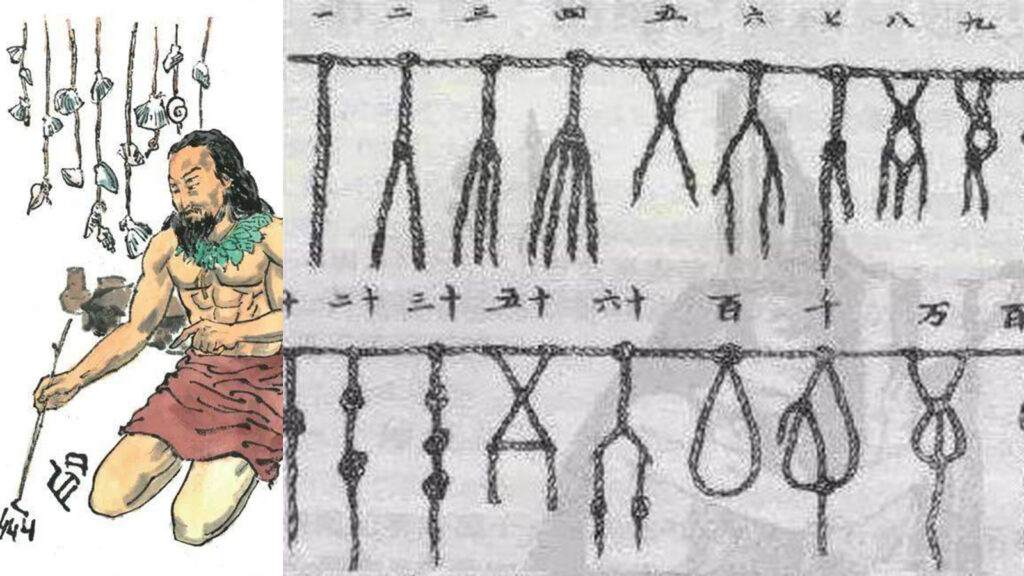Below is the story of Cangjie Inventing Chinese Characters
Long ago, our ancestors lived in this world and communicated in various ways, but there were no written characters back then. They often used knots on ropes to remember things, like how many sheep they had or how much grain they had planted. However, as life changed, these knots became increasingly complex and difficult to remember.
There was a very smart man named Cangjie. Cangjie was an official under the Yellow Emperor, and he was very observant. One day, when he went hunting with the villagers, he noticed that each animal’s footprint was unique. This gave him an inspiration: if each thing had a unique symbol, wouldn’t it be easy for us to remember them?
So, Cangjie began to experiment with creating these symbols. He observed the shape of the sun and drew a round symbol to represent it. He saw a tree and drew a tall, branching symbol to represent it. When he saw a sheep, he drew a curved horn shape to represent the sheep.

Cangjie’s creations amazed the villagers. They found that these symbols were not only easy to remember but could also convey more complex information. So, Cangjie began teaching the villagers how to use these symbols, and he continued to create more symbols to represent more things.
When the Yellow Emperor heard about Cangjie’s invention, he was very pleased. He ordered Cangjie to travel to different tribes and teach them this method, so that more people could learn and use these symbols. Over time, these symbols became richer and more complex, eventually evolving into the characters we use today.
Little ones, do you know? The Chinese characters we learn now were created bit by bit by Cangjie and his descendants. So, when we learn Chinese characters, we should be grateful for Cangjie’s wisdom and hard work, as well as those who have contributed to the inheritance and development of Chinese characters. Now, let’s also work hard to learn Chinese characters and pass on this precious cultural heritage!
Here below is the story analysis of Cangjie inventing characters:
- Background Introduction:
- Cangjie, hailed as the ancestor of Chinese characters, was an important figure during the era of the Yellow Emperor.
- Initially, people used knot tying to record important events and quantities of items in their daily lives. However, over time, this method gradually became insufficient to meet people’s needs.
- Problem Arising:
- The Yellow Emperor assigned Cangjie to manage the number of livestock and the amount of food stored in the village. As the number of livestock and food storage increased and changed, Cangjie found it difficult to rely solely on memory to fulfill this task.
- Cangjie first tried using knots on ropes to record, but soon discovered that this method was inconvenient when reducing quantities.
- Subsequently, Cangjie adopted the method of hanging shells on ropes as a substitute, which, to a certain extent, solved the problem. However, as the number of administrative tasks increased, Cangjie realized that a more efficient and accurate recording method was needed.
- Inspiration and Creation:
- During a collective hunt, Cangjie observed that different animals left distinctive footprints, which inspired him to use symbols to represent different things.
- Cangjie began creating various symbols to represent the things he managed, and these symbols gradually evolved into the earliest forms of characters.
- Promotion and Impact:
- The Yellow Emperor greatly praised Cangjie’s creation and ordered him to teach this method to various tribes.
- Over time, the usage of these symbols gradually spread throughout society, laying the foundation for the writing system we use today.
- Mythological Elements:
- According to legend, when Cangjie created the characters, millet rained from the heavens, and ghosts wept at night. These mythological descriptions reflect people’s awe and reverence for Cangjie’s great achievement in creating characters.
- Conclusion:
- The story of Cangjie inventing characters not only showcases the wisdom and innovative spirit of ancient people in solving daily problems, but also embodies their pursuit and respect for knowledge and culture. Through this story, we can gain a deeper understanding of the origin and evolution of Chinese characters and their significant role in the development of Chinese civilization.

